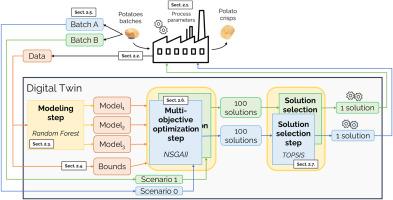A digital twin integrating multi-objective optimization to support fryer operators in managing potato crisps production
IF 5.8
2区 农林科学
Q1 ENGINEERING, CHEMICAL
引用次数: 0
Abstract
The production of potato crisps currently relies on the expertise of human operators, known as fryers, whose training is long and demanding. With the decline in fryer vocations and the increase in consumer quality expectations, it is now essential to develop decision-support tools to make fryer work easier and better control product quality. This study proposes a digital twin (DT) approach that incorporates multi-objective optimization to assist fryers in managing their crisp production line. Data from crisp production is collected and used to model key crisp physicochemical indicators (Fat content, Moisture content, and Lightness) using a Machine Learning approach, specifically the Random Forest method. Then, a multi-objective optimization is carried out using the Non-dominated Sorting Genetic Algorithm II (NSGA-II) algorithm, which identifies optimal adjustments to enhance the three crisp physicochemical indicators. The optimization is tested on 2 batches of potatoes as inputs. The algorithm generates a set of optimal solutions, from which a final solution is selected using the Technique for Order of Preference by Similarity to Ideal Solution (TOPSIS) multi-criteria decision-making method. This solution provides practical recommendations for adjusting production parameters according to a given potato batch quality. The results show that physicochemical parameters of the crisps are similar after optimization, regardless of the quality the potato batch. Variation in potato batch quality is compensated by appropriate adjustments of the crisp manufacturing process parameters ensuring consistent and optimal production. In conclusion, this digital twin, integrating multi-objective optimization, proves to be a valuable tool for improving fryer decision-making and optimizing production line management.

集成多目标优化的数字孪生,支持油炸运营商管理薯片生产
薯片的生产目前依赖于人类操作员的专业知识,即所谓的炸工,他们的培训时间长,要求高。随着油炸工职业的减少和消费者对质量期望的提高,现在有必要开发决策支持工具,使油炸工工作更容易,更好地控制产品质量。本研究提出了一种数字孪生(DT)方法,该方法结合了多目标优化,以帮助油炸工管理其脆片生产线。收集脆片生产过程中的数据,并使用机器学习方法,特别是随机森林方法,对关键的脆片理化指标(脂肪含量、水分含量和亮度)进行建模。然后,采用非支配排序遗传算法II (non - dominant Sorting Genetic Algorithm II, NSGA-II)进行多目标优化,识别出提高三个脆理化指标的最优调整。以两批土豆作为输入,对优化进行了测试。该算法生成一组最优解,并采用与理想解相似的偏好排序技术(TOPSIS)多准则决策方法从中选择最终解。该解决方案为根据给定马铃薯批次质量调整生产参数提供了实用建议。结果表明,优化后的薯片理化参数基本一致,与薯批质量无关。马铃薯批质量的变化通过适当调整脆制工艺参数来补偿,确保一致和最佳的生产。综上所述,该数字孪生体集成了多目标优化,是改进炸锅决策和优化生产线管理的有价值的工具。
本文章由计算机程序翻译,如有差异,请以英文原文为准。
求助全文
约1分钟内获得全文
求助全文
来源期刊

Journal of Food Engineering
工程技术-工程:化工
CiteScore
11.80
自引率
5.50%
发文量
275
审稿时长
24 days
期刊介绍:
The journal publishes original research and review papers on any subject at the interface between food and engineering, particularly those of relevance to industry, including:
Engineering properties of foods, food physics and physical chemistry; processing, measurement, control, packaging, storage and distribution; engineering aspects of the design and production of novel foods and of food service and catering; design and operation of food processes, plant and equipment; economics of food engineering, including the economics of alternative processes.
Accounts of food engineering achievements are of particular value.
 求助内容:
求助内容: 应助结果提醒方式:
应助结果提醒方式:


